The AMD Zen and Ryzen 7 Review: A Deep Dive on 1800X, 1700X and 1700
by Ian Cutress on March 2, 2017 9:00 AM ESTBenchmarking Performance: CPU Rendering Tests
Rendering tests are a long-time favorite of reviewers and benchmarkers, as the code used by rendering packages is usually highly optimized to squeeze every little bit of performance out. Sometimes rendering programs end up being heavily memory dependent as well - when you have that many threads flying about with a ton of data, having low latency memory can be key to everything. Here we take a few of the usual rendering packages under Windows 10, as well as a few new interesting benchmarks.
Corona 1.3
Corona is a standalone package designed to assist software like 3ds Max and Maya with photorealism via ray tracing. It's simple - shoot rays, get pixels. OK, it's more complicated than that, but the benchmark renders a fixed scene six times and offers results in terms of time and rays per second. The official benchmark tables list user submitted results in terms of time, however I feel rays per second is a better metric (in general, scores where higher is better seem to be easier to explain anyway). Corona likes to pile on the threads, so the results end up being very staggered based on thread count.
Blender 2.78
For a render that has been around for what seems like ages, Blender is still a highly popular tool. We managed to wrap up a standard workload into the February 5 nightly build of Blender and measure the time it takes to render the first frame of the scene. Being one of the bigger open source tools out there, it means both AMD and Intel work actively to help improve the codebase, for better or for worse on their own/each other's microarchitecture.
LuxMark
As a synthetic, LuxMark might come across as somewhat arbitrary as a renderer, given that it's mainly used to test GPUs, but it does offer both an OpenCL and a standard C++ mode. In this instance, aside from seeing the comparison in each coding mode for cores and IPC, we also get to see the difference in performance moving from a C++ based code-stack to an OpenCL one with a CPU as the main host.
POV-Ray 3.7
Another regular benchmark in most suites, POV-Ray is another ray-tracer but has been around for many years. It just so happens that during the run up to AMD's Ryzen launch, the code base started to get active again with developers making changes to the code and pushing out updates. Our version and benchmarking started just before that was happening, but given time we will see where the POV-Ray code ends up and adjust in due course.
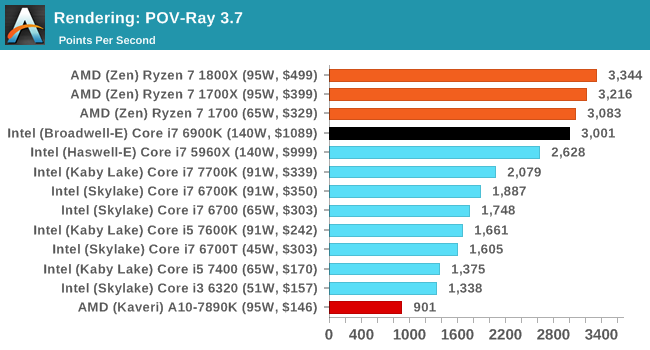
Cinebench R15
The latest version of CineBench has also become one of those 'used everywhere' benchmarks, particularly as an indicator of single thread performance. High IPC and high frequency gives performance in ST, whereas having good scaling and many cores is where the MT test wins out.
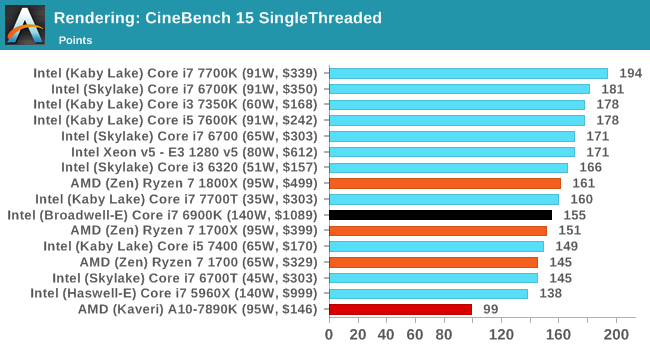
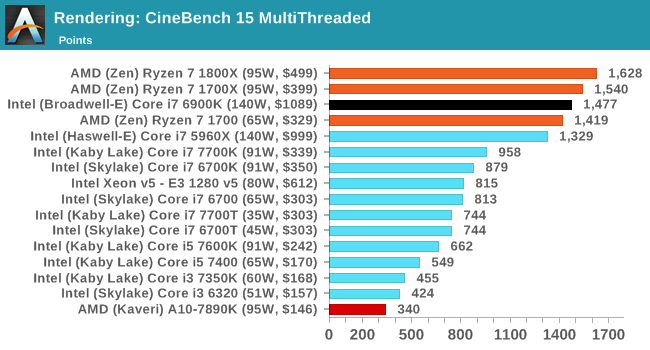


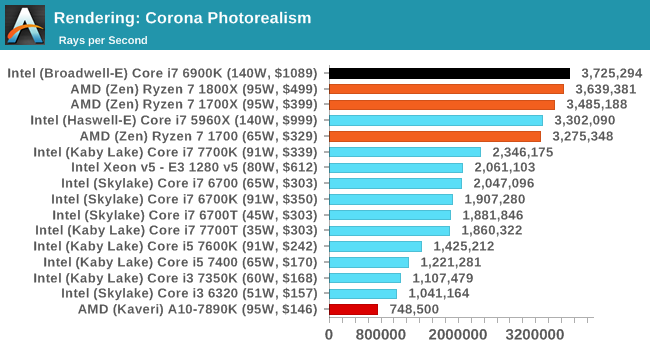
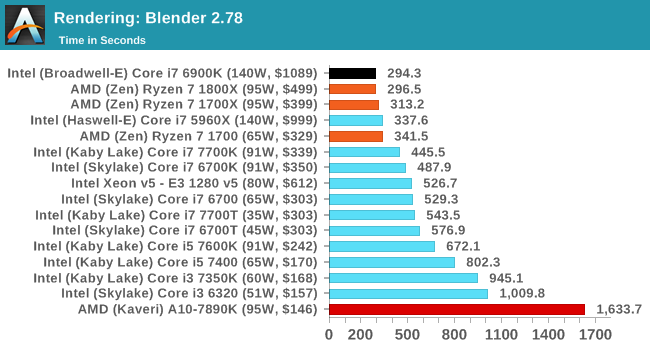

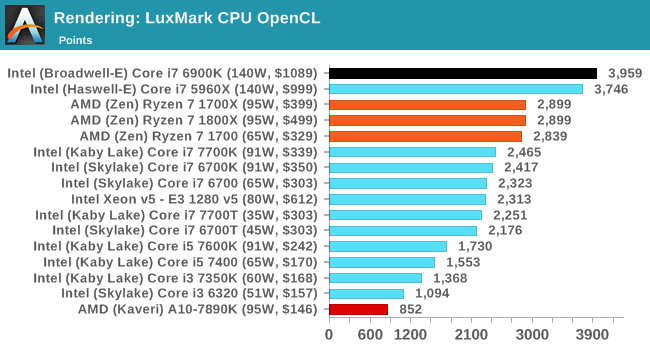








574 Comments
View All Comments
theuglyman0war - Saturday, March 4, 2017 - link
I'd like to see a lot more older i7 extreme editions covered all the way to westmere so I can sell clients on new builds with such a comparison.mapesdhs - Sunday, March 5, 2017 - link
Which older i7s interest you specifically?theuglyman0war - Saturday, March 4, 2017 - link
Checking what I paid last month for i7-7700k at Microcenter...Although I did get the motherboard combo price sale they "usually" offer...
The supposed $60 off for $319 is the cheapest price I found with a quick survey of new egg, amazon etc... And only $20 less then what I paid! Hardly A slashed priced answer shot across the bow by Intel! Not by a long shot!
I thought I was going to recommend the new cheap price to all my customer's new builds but I am pushing RYZEN and AM4 for a real combined price that makes a difference. ( the cheap price for enthusiast Am4 is enticing but the loss of PCI lanes is of concern for extreme cpu comparison anyway. Not so much compared to i7-7700k though which brings the comparison back to 16 lane parity! )
theuglyman0war - Saturday, March 4, 2017 - link
Could anyone actually point me to the amazing slashed deals that "BEAT" what I couldn't get last month by a long shot?( which was $349 BEFORE rebate. In other words it's not like there were not sales last month as well. And I see nothing now that really amounts to AMAZING compared to last month? )
Pretty dam insulting from somewhere in the pipe? Not sure if it's Intel. Or it's resellers clinging on to greedy margins not reflecting the savings to save their own ass's and bottom line due to stock considerations? Which iz no excuse considering the writing was on the wall. Someone needs to do a lot better. A heck of a lot better. Particularly considering I was thinking I could jes laff off AMD with an Intel savings and now have egg on my face! :)
rpns - Saturday, March 4, 2017 - link
The 'Test Bed Setup' section could do with some more details. E.g. what BIOS version? Windows 10 build version? Any notable driver versions?These details aren't useful just now, but also when looking back at the review a few months down the line.
jorkevyn - Saturday, March 4, 2017 - link
why they don't get 4 channel for DDR4 memory? I think, if you get that you will may be the real I7 6950K Killersedra - Saturday, March 4, 2017 - link
have a look at this:"Many software programmers consider Intel's compiler the best optimizing compiler on the market, and it is often the preferred compiler for the most critical applications. Likewise, Intel is supplying a lot of highly optimized function libraries for many different technical and scientific applications. In many cases, there are no good alternatives to Intel's function libraries.
Unfortunately, software compiled with the Intel compiler or the Intel function libraries has inferior performance on AMD and VIA processors. The reason is that the compiler or library can make multiple versions of a piece of code, each optimized for a certain processor and instruction set, for example SSE2, SSE3, etc. The system includes a function that detects which type of CPU it is running on and chooses the optimal code path for that CPU. This is called a CPU dispatcher. However, the Intel CPU dispatcher does not only check which instruction set is supported by the CPU, it also checks the vendor ID string. If the vendor string says "GenuineIntel" then it uses the optimal code path. If the CPU is not from Intel then, in most cases, it will run the slowest possible version of the code, even if the CPU is fully compatible with a better version."
http://www.agner.org/optimize/blog/read.php?i=49&a...
HomeworldFound - Saturday, March 4, 2017 - link
Everyone here already knew that ten years ago.Notmyusualid - Sunday, March 5, 2017 - link
Indeed it was.sedra - Sunday, March 5, 2017 - link
it is worth to bring it up now.